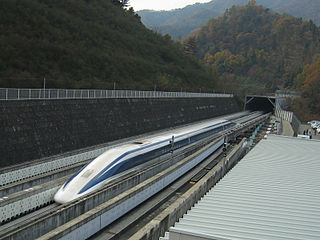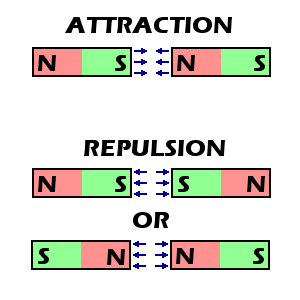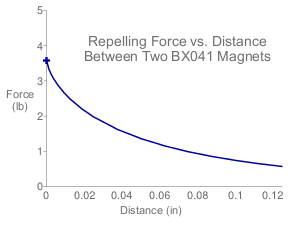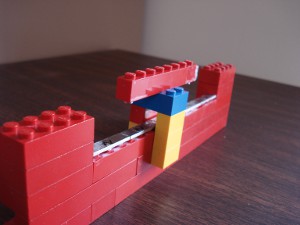what magnets repel how to make a maglev track
Maglev Trains 






One pop science experiment nosotros are oftentimes asked almost is the magnetic levitating train. We built a bones version of this experiment to highlight some of the challenges and solutions of a project like this.
What magnets should exist used? How much weight will it hold? Why won't the magnet just float by itself?
Repelling magnets

Every magnet has both a north and a s pole. When you place the north pole of ane magnet near the s pole of some other magnet, they are attracted to one another.
When you place similar poles of two magnets near each other (north to n or south to south), they will repel each other. This repelling force is what holds up a levitating train. Unfortunately, harnessing this repelling force is not and then simple.
Stability is a problem
A magnet sitting in a higher place a magnetic track won't simply float in the air by itself. Left unsupported, it will tend to rotate and flip around to attract to the magnets in the track. A mechanical constraint is required to continue it stable.
Read more about stability issues with repelling magnets in our Magnet Basics article.
Tin can't I just add magnets to make it stable?
No. Earnshaw'due south theorem says you can't. No thing how many magnets you use, you can't get a floating magnet to be stable with whatever number of permanent magnets holding it up. Stability must come from some other method, including agile feedback, spinning gyroscopes, mechanical stability, pyrolytic graphite, etc.
How strong is the magnet'southward repelling force?

The force depends on the size of the magnets and the distance between them.
Let's consider the magnets used in this train example, the i" x 1/4" x 1/8" thick BX041 block. Use our Repelling Magnet Reckoner to decide the force between two of these magnets arranged with like poles facing each other.
You can notice a graph of Pull Force vs. the distance between the magnets either using the reckoner, or under the "Technical" tab on the BX041 product folio as Pull Force, Case three. This graph is shown at right.
What does this graph mean? The repelling forcefulness depends on the distance between the magnets. When you clasp two of these magnets together so that they are simply touching, one magnet will push the other away with a force of about 3.five lb. The farther autonomously the magnets are, the weaker the force. When separated by a gap of about 0.08" (2mm), the force drops to just under one lb.
To plough the problem on it's head, the data can give you the reverse reply. For example, if the mass of a railroad train made on one of these magnets is 1 lb, await the altitude between the train magnet and the track to be approximately 0.08". If you add weight to the train, the gap will get smaller.
The actual setup with a bunch of magnets in a row is a bit different than the magnet-to-magnet results presented hither and in the calculator. It's a stretch to assume that the results are nevertheless valid. However, it's a good initial estimate.
Track construction

BX041 magnets shown with long lego pieces.

A demonstration train using D33 and D31 magnets in the train, and BX041 magnets for the runway.
We chose a length of BX041 magnets to create the track. They are strong enough to repel a small railroad train, yet inexpensive enough to build a demonstration length of track on a pocket-size upkeep. For the building materials, we grabbed an onetime box of Lego bricks.
When putting downwards magnets for the rails, the aforementioned pole on each magnet must face upwardly. Choose north or south, but they all must exist the same. For help identifying the poles, see Which pole is Due north? Nosotros marked all the s poles of our magnets with a marker to make this easier to call up and visualize.
Assembling magnets like this can be difficult. When two magnets are placed side by side with the same pole facing upwards, like poles are pushed next to each other. In this orientation, the magnets repel each other. To get them to line upwards, they need to be clamped and glued in place, resisting the force that repels them from i some other.
We first tried gluing these magnets to long Lego blocks with SuperGlue, but the Lego surface wasn't very good for this. The raised lettering wasn't a good surface. For better results, we sanded the tops of the lego blocks to remove the raised lettering and provide a apartment surface.
We also tried E6000 (a popular craft adhesive) and 2-part epoxy. These can also piece of work, but y'all accept to be careful non to brand a mess of the sides of the track. As shown at left, the train grabs the sides of the rails for stability. Any bumpy glue sticking out the sides of the track volition rub confronting the railroad train, adding unwanted friction. Also, these glues require a much longer dry out time. E6000 requires a few hours to gear up upwardly, while 5-minute epoxy takes five-ten minutes. SuperGlue can exist completely adhered in less than a infinitesimal of holding information technology with your fingers.
Performance and Results
It levitates! How much weight can it hold? The more weight on the train, the smaller the gap betwixt the magnets. All of these examples float well enough to demonstrate the forces involved. Check out the video below to watch a few different trains we constructed with this test track.
The most frustrating result is the friction induced by the stabilizing sides of the train. They rub constantly on the sides of the track, slowing the train down. The attraction of using magnets instead of wheels on a regular train track was to reduce friction, but it appears that some friction is unavoidable.
Commercial maglev trains use electromagnets (and sometimes rare earth magnets) that are controlled with feedback to stabilize the railroad train. Even so, they are not zero-friction systems – they still take to push air out of the way!
Ideas to explore
The construction of the track with Lego pieces was a quick solution, but not perfect. What other blazon of rails construction might be tried? How would curved tracks be constructed?
Would stronger magnets offering more than repelling strength? Sure. You could build a track with larger BX042 magnets, or even become with something wider like a BX082.
Additional info
Gluing magnets together tin be the virtually frustrating part of edifice this experiment. The video below shows the best method we came upwardly with using Legos and SuperGlue.
Source: https://www.kjmagnetics.com/blog.asp?p=maglev-train
0 Response to "what magnets repel how to make a maglev track"
Postar um comentário